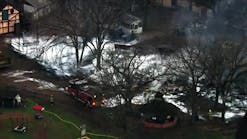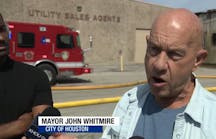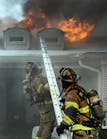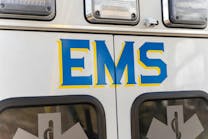"Engine 1 to Command."
"Proceed, Engine 1."
"Chief, we have knocked down all visible fire, we still have medium smoke and high heat conditions. The primary search is not completed."
Command could see heavy smoke pushing from the attic vents on the front of the building. The conditions he was observing were different from the progress report he was receiving from Engine 1.
"Command to Engine 1. Hey, Cap, we still have heavy smoke conditions coming from the building."
"That's affirmative, chief. The truck company is opening the walls and ceilings to check for hidden fire."
"Truck 3 to Command. Chief, we have heavy fire pushing from the rear attic vents, we are in the process of opening the roof."
Photo by Joe Hoffman Firefighters assigned to overhaul duties check the walls of a classroom for signs of hidden fire. A close examination ensures that every location where hidden fire could still be burning is searched thoroughly.
The units operating on the interior exposed fire in the walls and ceilings and started to knock it down, Conditions started to improve. The heavy smoke started to lighten up, indicating that the hoselines were reaching the seat of the fire.
"Command to Staging. Have a truck company take their salvage covers to the interior and start salvage operations."
The fire had heavily damaged two bedrooms on the top floor of the two-story dwelling and water was starting to drip through a ceiling light fixture onto the first floor. The salvage company pushed the furniture aside and covered it. The firefighters checked the electric to make sure it had been shut off. They pulled the light fixture away from the ceiling and placed a debris can beneath it to collect the dripping water. Other members of the truck company had gone to the undamaged rooms on the second floor. There, picture frames were removed from the walls and placed on the beds, the furniture was pushed to one side and covered.
"Engine 1 to Command. Chief, we have opened the walls and ceilings and exposed the hidden fire. The primary search has proven negative. Conditions on the interior have greatly improved."
"Command to Truck 3. Give me a progress report."
"Chief, it is looking pretty good, we have opened the roof. All visible fire has been knocked down and only a few hot spots remain."
Overhaul in the fire service is "the checking of a fire scene to determine that no fire remains." A close examination ensures that every location where hidden fire could still be burning is searched thoroughly. Salvage is the preservation of the structure and its contents from additional damage from fires, smoke, water and firefighting activities.
"Overhaul" and "salvage" are distinctly different strategies that require planning for these operations to be successful. The specific needs at an emergency scene will dictate how these strategies will be implemented. An incident may be large enough to require the deployment of numerous units, including the assigning of a "salvage group" or "salvage sector," or small enough to have one or two units accomplish overhaul and salvage simultaneously.
Hidden Fire
Once a fire is under control, suspected areas must be examined for hidden fire. The fire officer must determine:
- Whether to open a specific area.
- Where to make the opening in a wall or ceiling.
- Whether a small opening or the entire wall or ceiling must be opened.
If an officer suspects fire in a hidden location, the order should be given to open the area. Hoselines should be stretched to locations that need to be opened. One hoseline can protect adjoining areas being investigated. Overhaul operations can occur in the fire building and exposed structures. Consideration must be given to the possibility of the spread of fire via horizontal and vertical openings. Signs of fire extending to these areas can be detected through indicators:
- Discolored paint or wall coverings.
- Smoke oozing or pushing from around baseboards or door/window moldings.
- Continued smoke generation after all visible fire has been knocked down.
- No abatement of heat conditions though the fire appears to be extinguished.
Areas of hidden fire can sometimes be detected by listening for crackling sounds of fire still burning, or touching walls or hidden spaces to feel for hot spots. If not found, a hidden fire can smolder for a long period with the potential for developing into a serious problem. Firefighters could leave the scene only having to return to extinguish the rekindled fire. The primary causes of rekindles are incendiary fires or careless firefighting.
Structural Stability
A concern of the incident commander during every phase of firefighting is whether the building is stable enough to continue interior operations. This ongoing size-up must continue during the overhaul and salvage stages.
Structural damage caused by the fire must be thoroughly investigated to ensure that firefighters can operate safely in the building. Are collapse indicators present such as wall cracks, or walls out of alignment? Some floors in older frame buildings may have sagged. Are they safe to operate on? Are there water tanks or air conditioner units on a fire weakened roof that pose a threat to firefighters operating beneath them?
A fire-weakened building should not be subjected to jarring impacts from axes. Saws should be used to open floors and roofs. This minimizes shocking jolts to the building that could create a collapse situation.
Lightweight building components should be checked for stability and damage. Extreme care should be made to prevent saws from cutting through these supports creating conditions for a possible failure.
What are the building's contents? The weight of merchandise can affect the building's stability. Is there a heavy load of stock or machinery that could affect the structural integrity of the building?
Bales of absorbent material can absorb great quantities of water. This will drastically increase the floor loading. Additionally, the bales can expand and push out walls and weaken building supports. When piled one atop another, they can shift and fall. Many firefighters have been injured and killed by falling bales.
In attached structures that have common masonry bearing walls, a problem often found is that wooden floor and roof joist abut in the wall sockets of these walls. Fire attacking the wooden beams in the original fire building can transmit fire to the adjoining beam through conduction of heat. The fire can smolder at this location for long periods.
Structural Overhauling
All buildings require thorough examination. Type of building construction can help determine what overhauling may be needed.
The fire-resistive building usually requires minimal overhaul. The investigation should concentrate on checking shafts and poke-through construction. The components of a non-combustible building will not add fuel to a fire but an investigation must be made to determine if any structural damage has occurred.
Frame and ordinary constructed building have components that will contribute fuel to the fire. There can be many concealed spaces that need to be checked. The heavy timber constructed building usually withstands the effects of fire, or is totally destroyed. Flooring may need to be opened to expose hidden fire.
Parts of a building damaged by the fire may create a dangerous situation and need to be removed such as a wall or roof sign, a window or roof air conditioner unit, or a hanging cornice. Once the emergency has stabilized, a consideration in opening a location to check for hidden fire should consider how the area will be repaired. An example would be checking an attic for fire extension. Ripping off roof shingles and placing a hole in the roof would provide access but expensive and time-consuming to repair. A better method would be to investigate the area from the interior. A trap door may exist through which a ladder can be raised into the attic, or the ceiling can be opened from below.
When opening floors to check for fire extension, the openings should be made close to floor joists, without cutting through the joists. This permits firefighters to inspect these areas while allowing repairs to be easily made.
When windows are broken to assist the firefighting efforts, all glass remaining in the frames must be removed during overhaul. A window opening can be cleared out to allow firefighters to remove burnt debris to the exterior of the building. Windows can be removed undamaged and set aside for reinstallation at a later date. If damaged and not repairable, they can be removed and discarded.
A building struck by lightning may require extensive overhauling. The intense heat of the lightning can be conducted throughout the building by the piping and wiring, starting many smoldering fires in the inner cavities of the structure. It will require a time-consuming investigation.
Contents Overhaul & Salvage
The building occupancy dictates the type of overhauling and salvage required. Care during overhaul operations can make a difference. Articles on the top of desks or bureaus can be gently swept into the top drawers by a firefighter.
Smoldering furniture and burnt clothing and mattresses should be removed and thoroughly extinguished outside. A smoldering bureau should be checked to see if the contents are involved in fire. If not, the drawers should be removed and placed in a safe location so that the contents can be salvaged.
Don't make the mistake of thinking that a mattress or overstuffed furniture that has been damaged by fire can remain inside. It is of no use to the occupants and will need to be discarded at a later date but most importantly it can contain a smoldering fire that can erupt after firefighters have left the scene. Pull apart all burnt areas and wet it down thoroughly.
Smoldering debris can be shoveled into debris cans and together with fire damaged items deposited in one exterior location. The removal of smoldering items minimizes additional smoke damage, and permits a safer working environment for the firefighters to complete their overhaul and salvage operations. These items can be thoroughly extinguished on the exterior, minimizing water damage to the fire building.
Exterior Overhauling
As debris is removed to the exterior, it should be placed where:
- It will not threaten the structure if the fire flares up.
- It will not damage shrubbery.
- It will not impede entry and egress from the fire building.
- It will not be handled again.
When removing articles from upper floors via window, the area below must be cordoned off to prevent firefighter injury. This can be accomplished by having a spotter on the ground to direct those firefighters operating above.
James P. Smith, a Firehouse® contributing editor, is a deputy chief of the Phila-delphia, PA, Fire Department and an adjunct instructor at the National Fire Academy in Emmitsburg, MD.





